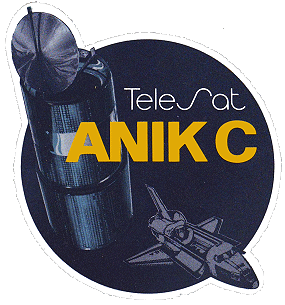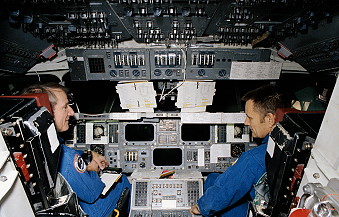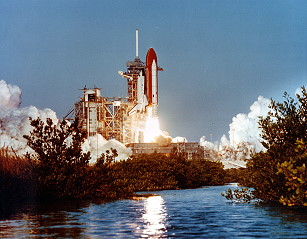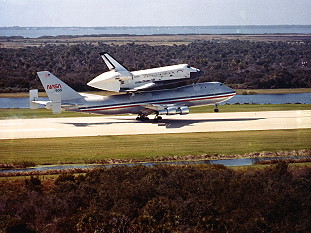Human Orbital Spaceflights
![]()
International Flight No. 85STS-5Columbia (5)5th Space Shuttle missionUSA |
 |
 |
|
 |
|||
![]()
Launch, orbit and landing data
walkout photo |
 |
||||||||||||||||||||||||||||
alternative crew photo |
|||||||||||||||||||||||||||||
alternative crew photo |
|||||||||||||||||||||||||||||
alternative crew photo |
Crew
| No. | Surname | Given names | Position | Flight No. | Duration | Orbits | |
| 1 | Brand | Vance DeVoe | CDR | 2 | 5d 02h 14m 25s | 81 | |
| 2 | Overmyer | Robert Franklin | PLT | 1 | 5d 02h 14m 25s | 81 | |
| 3 | Allen | Joseph Percival IV "Joe" | MS-1, EV-2 | 1 | 5d 02h 14m 25s | 81 | |
| 4 | Lenoir | William Benjamin "Bill" | MS-2, EV-1 | 1 | 5d 02h 14m 25s | 81 |
Crew seating arrangement
|
 |
|
||||||||||||||||||||||||
Hardware
| Orbiter : | OV-102 (5.) |
| SSME (1 / 2 / 3): | 2007 (5.) / 2006 (5.) / 2005 (5.) |
| SRB: | A15/16 |
| ET: | ET-5 (SWT-5) |
| OMS Pod: | Left Pod 02 - LV 01 (5.) / Right Pod 02 - RV 01 (5.) |
| FWD RCS Pod: | FRC 2 (5.) |
| RMS: | - |
| EMU: | EMU No. 1023 (PLSS No. 1006) / EMU No. 1022 (PLSS No. 1005) |
Flight
|
Launch from Cape Canaveral (KSC) and
landing on the Edwards
AFB, Runway
22. For STS-5, pyrotechnics have been removed from the two flight deck ejection seats and two mission specialist seats have been installed - one on the aft flight deck and one on the middeck. STS-5 became the first shuttle operational mission and the first mission with a crew of four including mission specialists. The deploy of communications satellites SBS-C (USA) and Telesat/Anik C-3 (Canada) were successful and subsequently propelled into their operational geosynchronous orbits by booster rockets. Predeployment activities for both satellites began about six hours before the spacecraft was ejected from the bay. Updated computations on Columbia's orbit - altitude, velocity, inclination - were fed to the spacecraft control center which in turn provides the mission control center in Houston with refined payload injection information. Then this was passed on to the mission specialist aboard Columbia in charge of the deployment. Shortly before ejection, Robert Overmyer oriented the Columbia to the prescribed deployment attitude (close to perpendicular to earth) with the cargo bay doors facing in the opposite direction of Columbia's direction of travel. When the orbiter was properly pointed a series of events were taken place under the watchful eyes of the mission specialist - William Lenoir for SBS-3, Joseph Allen for Anik C-3. The sun shield canopy was drawn back to expose the satellite. A 50-rpm spin was imparted to the cradle's turntable giving the satellite and attached Payload Assist Module a rotating action to stabilize their path. At the prescribed time explosive bolts were fired to release a Marman clamp holding the spring-loaded spacecraft down. It was separated from the orbiter moving away from the Columbia at about three feet per second, while continuing to orbit the earth at an altitude of 185 mi. (160 nm or 297.7 km), a velocity of about 28,164 km/h (17,500 mph) and an inclination of 28.5 degrees. The orbiter then moved away to a position about 26 km (16 mi.) from the satellite. The Columbia changed to an attitude so that the belly of the orbiter faced the satellite at the moment of the Payload Assist Module ignition. Satellite Business Systems' SBS-3 was the first commercial satellite to be launched from the Space Transportation System. SBS-3 was designed to provide all-digital communications and features time-division, multiple access techniques for efficient use of satellite transmission communications. The satellite was 2.1 m (7 ft.) in diameter and 6.4 m (21 ft.) tall when deployed in orbit. The exterior surface of the satellite was covered with approximately 14,000 solar cells that generate 1,000 watts of dc power. An onboard power subsystem, including rechargeable batteries, powered the satellite's communications subsystem, including 10 operational transponder channels. Redundant traveling-wave-tube amplifiers provide a transmit power of 20 watts for each channel. SBS-3 had a mass of about 3,277 kg (7,225 lb.) when ejected from the payload bay. This included the Payload Assist Module (PAM-D) with 1,960 kg (4,325 lb.) of solid propellant for thrusting the satellite from parking orbit to transfer orbit, an apogee kick motor with 495 kg (1,089 lb.) of solid propellant for synchronous orbit injection and the satellite itself, weighing 600 kg (1,326 lb.) including about 136 kg (300 lb.) of hydrazine fuel for eight to 10 years of stationkeeping operation. The Anik C-3 satellite was the first in a series to provide rooftop-to-rooftop transmission of integrated voice, video and data communications for Canadian businesses, carry newly licensed Canadian pay-TV and other broadcast services. Anik C-3 had a mass of about 632 kg (1,394 lb.) in geosynchronous orbit. Its solar cells produced more than 1,100 watts of dc electrical power to operate the spacecraft's systems. The satellite was 2.1 m (7 ft.) wide and 6.4 m (21 ft.) tall when fully deployed. The spin-stabilized Anik C-3 operated in the high-frequency radio bands, 14 and 12 GHz with 16 transponders. The combination of higher transmission power (from 15-watt output tubes) and the 14/12 GHz bands allowed the use of small 1.2 m (3.9 ft.) dish antennas in places, such as home rooftops and high-density office buildings. Anik C-3's antenna coverage included virtually all of populated Canada with four contiguous spot beams serving the western, west-central, east-central and eastern regions of the country. Telesat's customers were able to choose regional, half or whole nation coverage, depending on their needs. The spacecraft was built under contract by Hughes Aircraft Co., El Segundo, California. A planned EVA by Joseph Allen and William Lenoir was first delayed, because the astronauts suffered on the space adaption syndrome and was then cancelled because of spacesuit problems. It was planned that for approximately three and a half hours, William Lenoir and Joseph Allen should evaluate the spacesuit on its first outing in space and also test prototype space tool and repair devices. William Lenoir was scheduled to move toward the aft bulkhead along the starboard (right) slidewire while Joseph Allen monitors his motion. Joseph Allen then was scheduled to move along the port slidewire to join William Lenoir at the aft bulkhead. Enroute, both men should evaluate translation rates, handholds and safety tethers, spacesuit communications and television, floodlighting in the payload bay and potential work sites for contingency extravehicular activities. As part of the OAST program several more experiments were carried out. The primary objectives of the Aerodynamic Coefficient Identification Package (ACIP) were to collect aerodynamic data during the launch, entry and landing phases of the Shuttle, to establish an extensive aerodynamic data base for verification of and correlation with ground-based data, including assessments of the uncertainties of such data and to provide flight dynamics data in support of other technology areas, such as aerothermal and structural dynamics. Tile Gap Heating Effects (TGH) Experiment: The orbiter was instrumented with a removable panel 45.7 cm (18 in.) square, which will carry 11 tiles of baseline material and size. The panel was fitted to the underside of the orbiter fuselage. The gaps between tiles were be carefully calculated and controlled during fitting to ensure that the heating rates generated during entry will be no higher than those of the baseline tile array. The Catalytic Surface Effects (CSE) experiment investigated the chemical reaction caused by impingement of atomic oxygen on the Shuttle thermal protection system which was designed under the assumption that the atomic oxygen would recombine at the thermal protection system wall. A German materials science experiment failed due to a battery malfunction. The crew furthermore conducted three student-designed experiments during the flight. STS-5 was the first shuttle flight in which the crew did not wear pressure suits for the launch, reentry, and landing portions of the flight. |
Photos / Graphics
 |
 |
 |
 |
 |
 |
 |
 |
 |
 |
 |
 |
 |
 |
 |
 |
 |
 |
| © |  |
Last update on March 26, 2020.  |
 |